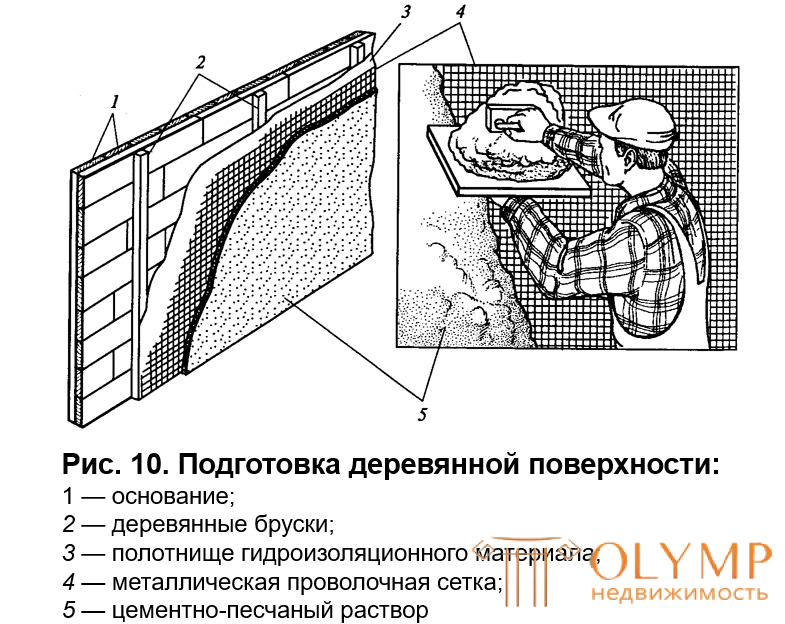
One of the main requirements for applied plaster coating is its strong adhesion to the main surface (from wooden products, stone, metal, concrete, etc.). The complex plastering process consists of a series of consecutive simple operations:
preparation of surfaces for plastering (notch, upholstery with mesh or shingles);
• staking and installation of beacons;
• putting plaster solution (spray and soil);
• leveling layers of tent;
• pull out the corners and slopes;
• application of a skim coat and grouting.
The substrate should be firmly bonded to the plaster. The surfaces to be plastered are cleaned from dust, dirt, grease and bitumen stains. Not enough rough surfaces are treated with a notch or sandblaster. Distinctive features of the preparation of surfaces for plastering, depending on the material of construction, are as follows.
Concrete surfaces : hemming, serving reinforcement, sealing sinks and holes. Cleaning surfaces with steel brushes and notching - drawing on the surfaces of grooves, depressions of a depth of 3 ... 5 mm, 1000 ... 1200 pcs. on.1 m2 using skarpel, catfish, ax, electric brush, jackhammer, sandblaster. In some cases, the surface is covered with a metal mesh. Preparation is completed by wetting the surface with water.
Brick surfaces : for walls laid out in vtestoshkovka - cleaning with brushes, felling of protruding seats, notching. If the masonry is lined flush, then additionally cut the seams to a depth of at least 1 cm. Additionally, it is necessary to clean the surface of the walls with steel brushes or sandblaster, trowels, and old brickwork is cut. For better adhesion with plaster slag-concrete surfaces, holes are drilled into them, into which plugs are installed, nails are driven in and wire braiding is arranged.
Metal surfaces - rust removal and metal mesh welding. Separate rods are pre-welded to the metal structures, a large metal mesh for fastening a thin metal mesh, the attachment of which to this framework should be carried out on twisting.
Wooden surfaces - drani packing, more often this process is carried out on insulating roll materials - roofing sheet or pergumin. To reduce sound and heat conductivity, wooden surfaces are closed with matting, felt and other materials before packing.
The bottom row is prostyle (uneven, thin, curved) 15 ... 20 mm wide and not thinner than 3 mm. It is nailed to the wall at an angle of 45 ° to the floor surface with a distance of 4 ... 5 cm between the shingles. The main or upper row - the output is flat, smooth of the same width and 4 ... 5 mm thick. The build-up of drains among themselves is carried out with a gap of 2 ... 3 mm. Nowadays, instead of separate drains, the surface of wooden structures is plastered with ready curtain shields before plastering. The maximum thickness of plastered vertical surfaces is 4 ... 5 cm, and horizontal and inclined — 3 ... 6 cm. If it is necessary to have a greater thickness of plaster coating, we use strips 5 ... 7 mm thick instead of drains. You can tack on the wall nails, placing them in a checkerboard pattern at a distance of 10 cm from one another, it is even better to nail the metal mesh.
The protruding architectural details, the junctions of the wooden parts of the building with stone, concrete and metal structures, as well as other surfaces, if necessary, apply plaster on them with a layer of more than 20 mm and are covered with Rabitz metal mesh with 10x10 mm cells. The joints of heterogeneous structures should be tightened with a metal grid so that cracks do not appear on the plaster, as the plaster mortar dries out at different times on dissimilar surfaces.
Stamping and installing stamps. In order for the applied plaster to be strictly vertical or horizontal, the surfaces are pre-fixed and leveled by marks and beacons.
The thickness of the plaster coating is outlined by hanging the surface. First, the walls and ceilings are hung over the cords, pulling them every 1.5 m. Then, marks are installed on the corners of the fixed surface - supporting areas of small pellets have a gypsum mortar, the upper surface of which determines the hanging line. Beforehand, in the process of hanging the wall, if there is such an opportunity, slaughtered at the corners and in the center of the nails so that it is at the level of the top of the thickness of the plaster. You can’t pin down the rule for nails, so they arrange 5x5 cm plaster marks.
Installation of beacons. Beacons are usually installed to perform high-quality plaster. Lighthouses come from lime mortar, gypsum and inventory. For ready-made brands impose a wooden lath (rule), under which they plaster the mortar. After the mortar is set, the slats are removed, and the gypsum strips obtained under them serve as beacons defining the fixed surface.
Inventory metal lighthouses suit from corner steel, and
wooden - from a bar. The fastening of metal lighthouses is carried out with the help of pins driven into the wall, and the wooden ones with nails.
Что бы оставить комментарий войдите
Комментарии (0)